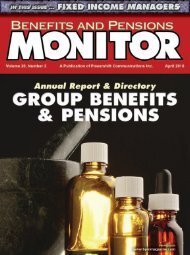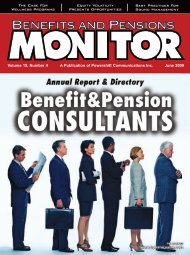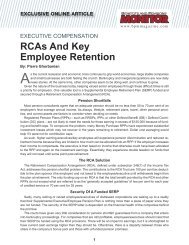BPM October 2010.indd - Benefits and Pensions Monitor
BPM October 2010.indd - Benefits and Pensions Monitor
BPM October 2010.indd - Benefits and Pensions Monitor
You also want an ePaper? Increase the reach of your titles
YUMPU automatically turns print PDFs into web optimized ePapers that Google loves.
Against this positive backdrop, however, investors still have to<br />
remember that frontier markets do carry higher individual risk. These<br />
are markets that are at the beginning of their evolution <strong>and</strong> this brings<br />
with it its own inherent challenges. What perhaps is more prudent for<br />
investors to consider, however, is that these markets are very much<br />
where emerging markets were 15 or 20 years ago. With investors gen-<br />
<strong>Benefits</strong> <strong>and</strong> <strong>Pensions</strong> <strong>Monitor</strong> – <strong>October</strong> 2010<br />
2010 Annual Report & Directory<br />
Figure 1:<br />
Frontier Markets Have Lagged Both<br />
Emerging And Developed Markets<br />
Source: Bloomberg (performance to 30 June 2010).<br />
Rebased to 100 as at 31 December 2008.<br />
Figure 2:<br />
Broad Opportunity Set To Explore<br />
As of 30 June 2010. Source: MSCI, S&P<br />
erally recognizing how important emerging markets are today to their<br />
equity allocation, an allocation to this area may prove sagacious.<br />
True Diversifi cation Benefi ts<br />
One of the challenges for investors in recent years has been the<br />
rising correlation among asset classes that has reduced diversifi cation.<br />
Even rising correlations among the more mature emerging markets<br />
have required investors to look farther afi eld for diversifi cation<br />
opportunities. Of course, while the recent fi nancial crisis emphasizes<br />
how strongly the world becomes correlated when we encounter a<br />
protracted slowdown <strong>and</strong> a subsequent bear market, frontier markets<br />
do continue to harbour greater diversifi cation benefi ts compared with<br />
their emerging counterparts. Not only have frontier markets tended<br />
to have much lower correlations to world equities than their more<br />
mature emerging market brethren, they also provide additional diversifi<br />
cation within the emerging market space itself.<br />
There are a number of reasons for this low correlation. Frontier<br />
markets remain quite local in character, driven by their own internal<br />
economic <strong>and</strong> political dynamics. Foreign investors also tend<br />
to play a less important role in these markets. Moreover, the small<br />
number of securities in many of these markets means companyspecifi<br />
c factors play a far more important role.<br />
The Search For Returns<br />
Due to their nature, it is more diffi cult to evaluate valuation metrics<br />
compared with other asset classes. Investors are hampered by<br />
a lack of reliable consensus earnings forecasts for most markets,<br />
while even historical valuation data can prove diffi cult to retrieve.<br />
Since January 2008, MSCI has calculated trailing P/E, P/B, dividend<br />
yield, <strong>and</strong> ROE data for each market. However, these multiples,<br />
while useful, can give a distorted view given that:<br />
◆ most country indices have only a h<strong>and</strong>ful of stocks <strong>and</strong> are thus<br />
heavily affected by company-specifi c anomalies<br />
◆ earnings visibility is generally low in these markets<br />
It is clear, however, from data now available that frontier markets<br />
have become less expensive. The region’s trailing P/E has fallen from<br />
17.8x in February 2008 to 13.2x as of June 2010, while the P/B has<br />
fallen from a 3.3x to 1.4x over the same period. This is a reasonable<br />
de-rating <strong>and</strong> does represent reasonable value.<br />
As we discussed earlier, however, 2009 has seen frontier markets<br />
underperform. Much of this can be attributed to their more mature<br />
counterparts, with the reality being that back in February 2009,<br />
when investors were venturing back into the emerging space, they<br />
were primarily attracted to the larger BRIC countries. These were<br />
large economies that investors were confi dent of surviving the crisis<br />
<strong>and</strong> that were trading at historically low valuations. In other words,<br />
why invest in perhaps more unknown entities such as Oman, Qatar,<br />
Nigeria, Vietnam, etc. when it was possible to invest in China on low<br />
double-digit valuations. Consequently, the larger emerging markets<br />
enjoyed strong returns, while frontier market prices struggled.<br />
With valuation discrepancies rising, however, it may require<br />
investors to look elsewhere within the emerging world to fi nd value.<br />
If true, this could herald a wave of interest again for frontier markets.<br />
This may have already started with the fi rst half of 2010 refl ecting<br />
outperformance versus other regions of the world.<br />
A key consideration for investors is the diffi culty of generalizing<br />
across a widely dispersed set of economies facing very different levels<br />
of development, economic conditions, <strong>and</strong> structural constraints.<br />
Frontier markets are not homogenous. There is considerable varia-<br />
39









